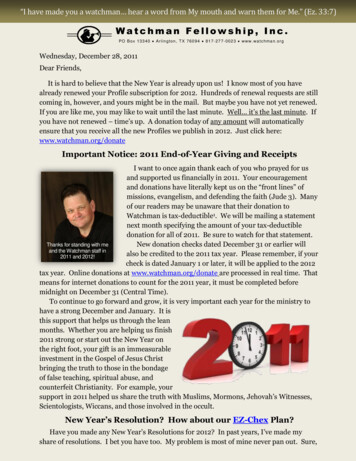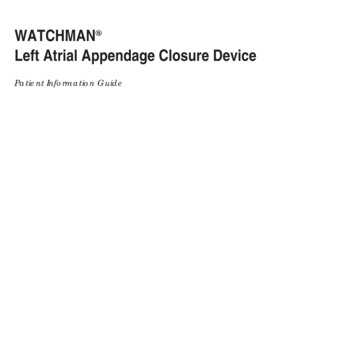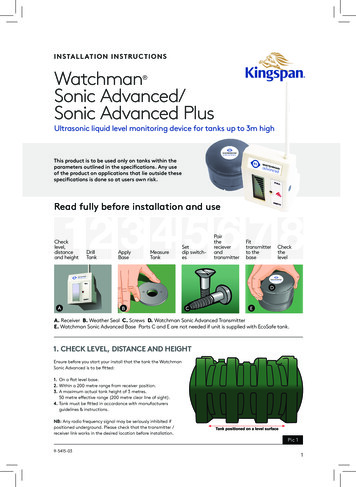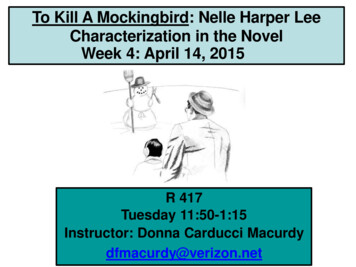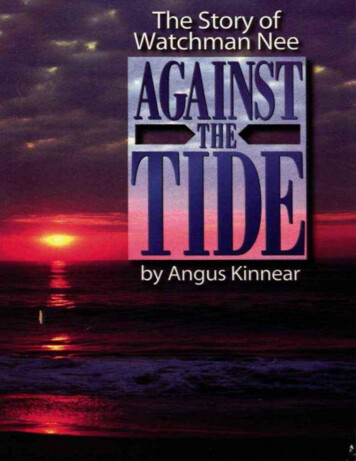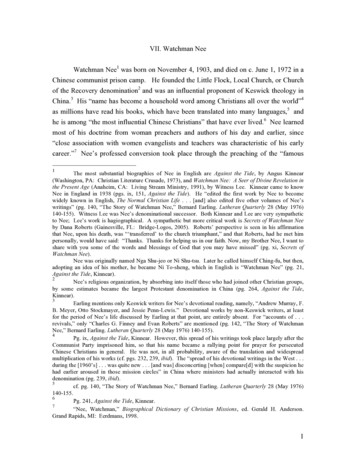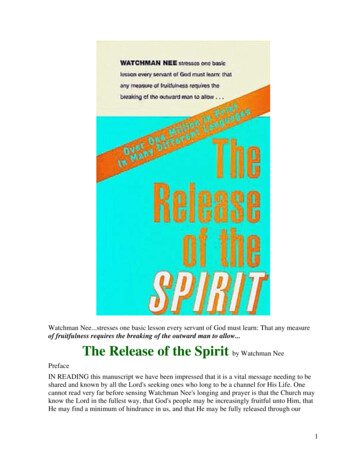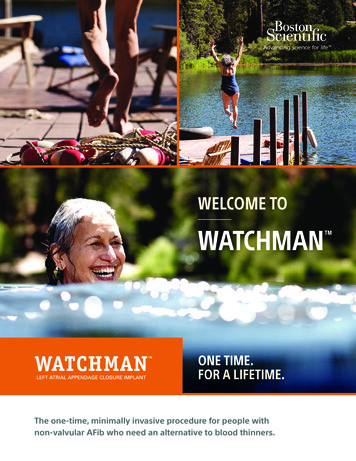
Transcription
WELCOME TOWATCHMAN ONE TIME.FOR A LIFETIME.The one-time, minimally invasive procedure for people withnon-valvular AFib who need an alternative to blood thinners.
MORE THAN 200,000 PEOPLEHAVE LEFT BLOOD THINNERSBEHIND WITH WATCHMAN .Non-valvular AFib can mean a lifetime of blood thinners.It can also mean a lifetime of worry about bleeds from falls,other medical issues, or an unexpected surgery.When I was on blood thinners,it was always a different life.WATCHMAN was a lifesaver. Itput me back to being who I was.—CLIFF, 68The WATCHMAN procedure is a trusted alternative thatpermanently reduces both stroke risk and bleedingworry. With almost 20 years of clinical and real-worldexperience—including 10 clinical trials—it is proven to besafe and effective.Here’s what you’ll find inside this brochure.STROKE RISK REDUCTION OPTIONSWHAT WATCHMAN IS AND HOW IT WORKSBEFORE, DURING AND AFTER YOUR PROCEDURELIVING LIFE WITH WATCHMANHOW TO GET IN TOUCH WITH USRead on to learn more about WATCHMAN.3
STROKE RISK REDUCTION OPTIONSTHE GOAL: REDUCING YOUR STROKE RISK.BLOOD THINNERS ARE ONE WAY.Blood thinners reduce the risk of clots that could lead to a stroke.Anti-platelet medicines,including aspirin, keep plateletsin the blood from stickingtogether and forming clots.Anti-clotting medicines, such as warfarin (Coumadin ),Xarelto (rivaroxaban), Eliquis (apixaban), Pradaxa (dabigatran), and Savaysa (edoxaban) also help preventclots from forming in your blood.Blood thinners are effective, but can come with challengesand potential bleeding worries.Major and minor bleedingrisks from other medicalconditions or fallsLifestyle activities thatcarry a risk of bleedingDifficulty with once- ortwice-daily pill dosingI was restricted on bloodthinners and now I canjust go to where I want to goand do what I want to do.—MICHAEL, 79Is WATCHMAN right for you?WATCHMAN is indicated for people who haveAFib not caused by a heart valve problem(also known as non-valvular AFib), have beenrecommended for blood thinning medicinesby their doctor, and can take short-term bloodthinners but need an alternative.96% OF PEOPLEWERE ABLE TO DISCONTINUETHEIR BLOOD THINNER AT45 DAYS WITH WATCHMAN1WATCHMAN may be right for you if:Complications duringsurgeryHigh ongoing costIf taking warfarin, regularmonitoring and food/druginteractionsYou have a lifestyle, occupation, or health concern that puts youat risk for bleedingYou’ve had major bleedingwhile taking blood thinnersWATCHMAN IS AN ALTERNATIVE.It’s a one time, minimally-invasive procedurethat permanently reduces stroke risk without theworries that come with a lifetime of blood thinners.For some people, that means an extra measure of safety if theyhave bleeding due to certain medical conditions, such as an ulcer.For others, it means peace of mind should they need surgery. Amore active lifestyle is also less risky, including travel that’s notnear medical help.4You have difficulty takingblood thinners as prescribedby your doctorTalk to your cardiologists about the benefitsand risks. Together, you’ll decide if WATCHMANis right for you.1. PINNACLE FLX 12-month primary safety and efficacy endpointresults, Doshi, SK. presented at HRS 2020 Science. 2. ArmstrongS, Amorosi SL, Patel P, Erickson GC, Stein K. Medicare beneficiaryout-of-pocket spending for stroke prevention in non-valvular atrialfibrillation: a budget analysis. Value Health (ISPOR). 2015;18:A1-A307(A40,PMD13). 3015(15)00296-X/pdf. Accessed March 28,2019.What about cost?While blood thinners must be taken everyday for life and represent an ongoing cost,WATCHMAN is a one-time procedure andone-time cost. This means WATCHMAN cansave you money over time. For example, thetotal out-of-pocket spending for WATCHMANis lower than warfarin by year 2 and half thecost by year 5.2Medicare covers WATCHMAN for eligiblepatients and an increasing number of otherinsurers do, too. Insurance coverage can varysignificantly from one plan to another. Besure to contact your insurance carrier for anyspecific questions.5
WHAT WATCHMAN IS AND HOW IT WORKSTAKING A CLOSER LOOKAT WATCHMAN .With WATCHMAN, I can forgetabout the concern of a stroke.I can forget about the concernof side effects from drugs and justtry to live a happy, healthy life.First things first:what is WATCHMAN?WATCHMAN is a small, flexible implantabout the size of a quarter. It is made fromvery light, compact materials commonlyused in many other medical implants.—AJ, 68 1 INCHIt is placed into your heart during aminimally invasive procedure andnever needs to be replaced.How exactly does it work?To understand how WATCHMAN works, ithelps to understand the connection betweenAFib and stroke.LEFT ATRIALAPPENDAGE(LAA)Atrial fibrillation, or AFib, affects your heart’sability to pump blood normally. This can causeblood to pool in an area called the left atrialappendage, or LAA. There, blood cells can sticktogether and form a clot. When a blood clotescapes from the LAA and travels to another partof the body, it can cut off the blood supply to thebrain, causing a stroke.1,2In people with AFib not caused by a heart valveproblem, more than 90% of stroke-causing clotsthat come from the heart are formed in the LAA.1That’s why closing off this part of the heart isan effective way to reduce stroke risk.The WATCHMAN Implant fits rightinto your LAA. It’s designed topermanently close it off and keepthose blood clots from escaping.6Is WATCHMAN safe?200,000 20 YEARSOver 200,000 people have alreadyreceived the WATCHMAN Implant. Withalmost 20 years of clinical and real-worldexperience — including 10 clinical trials —WATCHMAN has a proven safety record.Advanced, Heart-Friendly DesignScience always looks for ways to make effective treatmentseven better. WATCHMAN is no exception. The WATCHMAN FLXdesign is an advancement that enables the implant to fit agreater number of patients, giving more people than ever a safe,effective alternative to blood thinners should they need one.Learn more about WATCHMAN and how it works atwatchman.com/video1.Blackshear JL, Odell JA. Appendage obliteration to reduce stroke in cardiac surgical patients with atrial fibrillation. AnnThorac Surg. 1996;61:755-759. 2. National Stroke Association. Making the Afib-Stroke Connection. es/Afib-Connection%20for%20hcp.pdf. Published 2012. Accessed September 1, 2016.7
BEFORE, DURING AND AFTER YOUR PROCEDURETHE WATCHMAN PROCEDURE:WHAT TO EXPECT.OF PEOPLE WERE ABLE TO DISCONTINUETHEIR BLOOD THINNER AT 45 DAYS1The decision to get WATCHMAN is shared between you and your doctor.You’ll talk about what’s important to you, your goals, and the procedure’srisks and benefits. Together, you’ll decide whether WATCHMAN is theright choice for you. If so, here is what comes next.BEFOREDURINGAFTERGETTING READY.PROCEDURE DAY.YOUR FIRST YEAR WITH WATCHMAN.Get insurance approval. WATCHMAN iscovered for eligible Medicare patients anddoes not require advance approval. If you havecommercial insurance, you may need priorauthorization from your plan. Your doctor’soffice may be able to assist.The minimally invasive WATCHMAN procedure isdone under general anesthesia and takes aboutan hour. Patients commonly stay in the hospitalovernight and leave the next day.DAY 1WEEK 1STEP 1Choose a medical center. You and your doctorwill decide on a center. You can view options atwatchman.com/centers, and your doctor willprovide a referral. Typically, the medical centerwill call you to schedule a consultation, or yourdoctor’s office may schedule it for you.Similar to getting a stent, yourdoctor makes a small cut inyour upper leg and inserts anarrow tube.Have an exam and heart scan. In addition toa physical, you may have a special test called aTEE (transesophogeal echocardiogram) whichtakes pictures of your heart so the doctor cansee your LAA and to make sure you don’t havean existing blood clot.STEP 2Set the date for your WATCHMAN procedure.Your doctor and implant team will tell youhow to prepare. Make sure you understand allthe instructions, including what medicationsyou should and should not take, and ask anyquestions you have.8Starting on day 1 and for about 45 days afterward, you’lltake a blood thinner while WATCHMAN and your heart’sown tissue work together to form a seal against clots.Most people can return to work within a few days.Gradually add activities to get back to your normal routine.Check with your doctor before resuming exercise oranything strenuous.DAY 45Your doctor then guidesWATCHMAN through thetube and into the left atrialappendage (LAA) of your heart.You’ll have a TEE imaging test to see if you’re ready tostop taking blood thinners. If so, you’ll begin taking anantiplatelet medication called clopidogrel (Plavix ) andaspirin. If not, you’ll have another TEE at 6 months.6 MONTHSIf you were able to stop taking your blood thinner at day45, you’ll now be able to stop taking your antiplateletmedication. You’ll keep taking aspirin on an ongoing basis.STEP 31 YEARAfter the procedure isfinished, you’ll stay inthe hospital overnightand leave the next day.Your doctor may schedule another TEE to check on yourimplant and make sure that your left atrial appendage isfully sealed.1. PINNACLE FLX 12-month primary safety and efficacy endpoint results, Doshi, SK.presented at HRS 2020 Science.Post procedure, I wasin the hospital for 24hours with great foodand a wonderful staff,and then home relaxingfor the next week witha bit of limitation onstrenuous activity.—SEAN, 849
LIVING LIFE WITH WATCHMANWATCHMAN .IT’S ONE TIME. FOR A LIFETIME.WANT TO KNOW MORE?LET US ANSWER YOUR QUESTIONS.WATCHMAN may provide a lifetime of stroke risk reduction that lets you leavelifelong blood thinner worries behind.After the WATCHMAN procedure, life is a lot less restricted. Without the constant concern of bloodthinner bleeds following you everywhere, you’re freer to be active, to travel, to go where you wantto go and do what you want to do. WATCHMAN protects you in all these situations.Out in the world with WATCHMAN.TRAVELYour WATCHMANImplant will not set offmetal detectors, so youcan go through securityscreenings without worry.MEDICAL ANDDENTAL PROCEDURESAlways tell the doctor ordentist that you have aWATCHMAN implant so heor she can work with yourcardiologist to determinethe best way to providetreatment—especially Ifthe procedure requiresyou to stop taking yourmedications as prescribed.TALK TO ANEDUCATION SPECIALIST.TALK TO A PATIENTAMBASSADOR.GET A CUSTOMIZEDDISCUSSION GUIDE.Our trained professionalshave healthcare experience.They’re here to answer yourWATCHMAN questions andhelp you get ready to talk toyour cardiologist.Our ambassadors haveWATCHMAN themselves andhave volunteered to share theirexperiences. We hand-picksomeone to talk with youbased on your questions.Ready to talk to yourdoctor about WATCHMAN?We make it easy. Answer afew questions and get adiscussion guide that’scustomized to your needs.Call 1-855-802-3909Mon-Fri, 8 am to 5 pm CTTo learn more, call1-844-355-9114Download it ateligibility.watchman.comMRIIf you need an MRI(magnetic resonanceimaging), it’s importantto show the doctor andMRI technologist yourWATCHMAN ImplantCard. WATCHMAN is“MRI conditional,” whichmeans you can safelyhave an MRI when yourtechnologist takescertain precautions.I didn’t have any problems getting the [WATCHMAN]procedure and I feel so much better since I had it. It makesme feel good that I can get up and go and not worry.—CAMILLE, 89What is a WATCHMAN Implant Cardand why do I need it?10You’ll get a WATCHMAN Implant Card from the medical centerthat performs your procedure. This very important card letsmedical personnel know that you have the WATCHMANimplant. Remember to carry it with you at all times and registerit in case it gets lost. Go to watchman.com/register.11
Important Safety InformationThe WATCHMAN and WATCHMAN FLX Devices are permanentimplants designed to close the left atrial appendage in theheart in an effort to reduce the risk of stroke. With all medicalprocedures there are risks associated with the implant procedureand the use of the device. The risks include but are not limited toaccidental heart puncture, air embolism, allergic reaction, anemia,anesthesia risks, arrhythmias, AV (Arteriovenous) fistula, bleedingor throat pain from the TEE (Trans Esophageal Echo) probe, bloodclot or air bubbles in the lungs or other organs, bruising at thecatheter insertion site, clot formation on the device, cranial bleed,excessive bleeding, gastrointestinal bleeding, groin puncturebleed, hypotension, infection/pneumonia, pneumothorax,pulmonary edema, pulmonary vein obstruction, renal failure,stroke, thrombosis and transient ischemic attack. In rare casesdeath can occur.Be sure to talk with your doctor so that you thoroughlyunderstand all of the risks and benefits associated withthe implantation of the device.Interventional Cardiology300 Boston Scientific WayMarlborough, MA 01752-1234www.bostonscientific.com 2022 Boston Scientific Corporationor its affiliates. All rights reserved.SH-887002-AA
WATCHMAN is a one-time procedure and one-time cost. This means WATCHMAN can save you money over time. For example, the total out-of-pocket spending for WATCHMAN is lower than warfarin by year 2 and half the cost by year 5.2 Medicare covers WATCHMAN for eligible patients and an increasing number of other insurers do, too. Insurance coverage can vary
